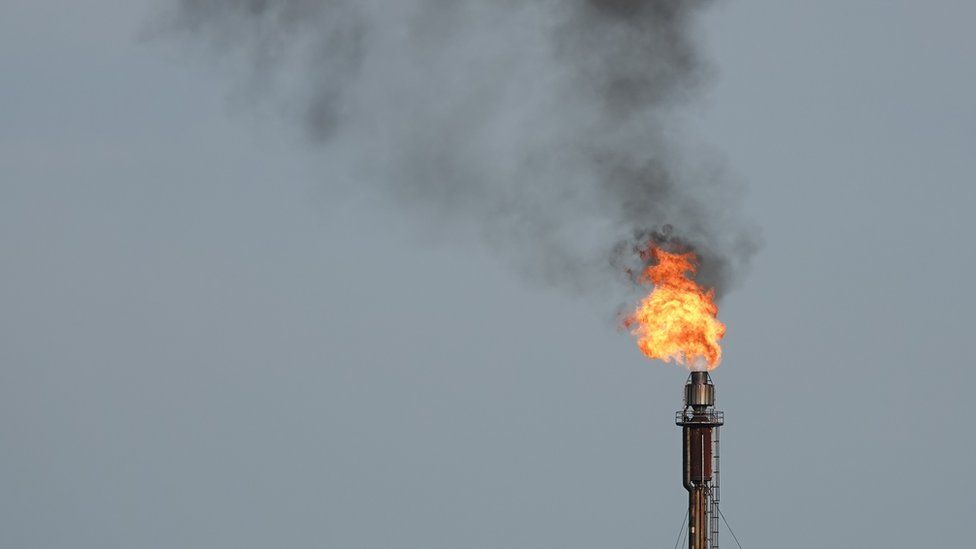ARTICLE AD BOX
 Image source, Nigel Harris/Getty Images
Image source, Nigel Harris/Getty Images
The main sources of methane are oil and gas production, farming and waste
By Esme Stallard
Climate and science reporter, BBC News
For the first time ever, a major leak in the UK of the extremely potent greenhouse gas methane has been spotted from space.
Its detection by satellite raises hopes that future leaks can be stopped more quickly.
Methane has 28 times the heating potential of CO2 and is a major contributor to global warming.
In energy terms, the gas leaked over three months before being stopped could have powered 7,500 homes for a year.
The leak from a pipeline in Cheltenham, revealed exclusively to the BBC, was discovered in March.
It was detected by Leeds University with the help of specialist satellites.
Methane - a greenhouse gas - is responsible for about 30% of the rise in global temperatures.
Emily Dowd, PhD researcher at the School of Earth and Environment and the National Centre for Earth Observation, University of Leeds, had been using satellite imagery to assess methane leaks from landfill sites. But she noticed on the images the distinct marker of a methane leak some miles away, coming from a gas pipeline owned by Wales and West Utilities.
Methane has a global warming potential 28 times greater than carbon dioxide over 100 years.
Identifying and tackling methane emissions is a crucial objective of the UK and other countries seeking to tackle climate change.
Upon discovering the leak Ms Dowd worked with GHGSat - whose satellites provided the original images - to take further surveys from space, while a team from Royal Holloway University made on-the-ground round measurements.
Ms Dowd said: "Finding this leak brings a question of how many there are out there and maybe we need to be looking a bit harder to find them and take advantage of the technology we have."
Wales and West Utilities said they became aware of the leak after a member of public reported the smell of gas. They said were in the process of obtaining the necessary permissions for replacing the gas mains when the leak was picked up by satellite.
But the satellite detection process has shown the potential of picking up methane leaks quickly.
The main sources of methane are the oil and gas industry, farming and landfill sites. UK methane emissions have fallen significantly since 1990 but in recent years progress has slowed.
Currently methane leaks are detected through routine on-the-ground surveys - a very challenging prospect when there are thousands of miles of pipes and sites. And the UK's methane emissions are only an estimate gleaned from economic activity data.
Jean-Francois Gauthier, senior vice-president for strategy at GHGSat told the BBC: "It's important to highlight that satellites are just one piece of the puzzle. But satellites have a very unique value ... that they can come back [and collect more images] very frequently and they can do so without the need to deploy people on the ground so they can do so effectively and also affordably."
The company has nine satellites in their constellation, which orbit at 500km overhead, and are some of the highest resolution devices able to see gases at 25m resolution.
Image source, BBC/Gwyndaf Hughes
Image caption,Optical gas imaging cameras used on the ground have previously identified methane leaks in the UK
The company has recently signed a £5.5m partnership with the UK - funded by the UK Space Agency - to provide satellite data on methane emissions to UK organisations such as Ordnance Survey.
The UK Space Agency's CEO, Dr Paul Bate, said: "Satellites are getting smaller and more powerful, giving us an ideal vantage point from which to monitor global greenhouse gas emissions and inform decision-making on the path to Net Zero."
There are still limitations with the satellites that will need to be developed.
Prof Grant Allen, lecturer in atmospheric science at the University of Manchester, told the BBC: "There is still some work to do to fully validate the precise magnitude of such emissions estimated by satellites like GHGSat, but the capability is already proving super useful for identifying where big (preventable) sources may be."

 1 year ago
60
1 year ago
60








 English (US) ·
English (US) ·